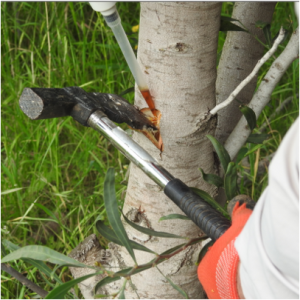Key Objectives
- Barrier removal – reestablish continuous flow and safe movement of water, sediments, plants, and aquatic animals.
- Natural channel form – recreate optimal structural conditions as a foundation for the entire stream ecosystem’s recovery.
- Habitat expansion – restore springs and adjacent natural areas to increase wetland habitats.
- Vegetation buffer – widen the riparian zone with native plants to improve water quality, flood buffering, and corridor function.
- Flora recovery – plant and seed native species, including rare and endangered ones.
Invasive species control – remove non-native plants to allow native species to flourish.

What are we doing in practice? A few examples…
● We conducted extensive surveys and monitoring before starting the work to ensure the planning was based on accurate data and to allow us to measure the impact of the restoration on the stream environment.
● We are restoring the stream channel by widening it, adding meanders, and softening the slopes of the banks, bringing it back to its natural structure. (Read more about projects in the basin – in Hebrew)
● As part of the Citizen Science Project, teams of students and local residents help scientists survey various species of animals and plants in the stream. The collected data is used to assess the stream’s ecological condition.
● We plant and sow native vegetation in various restored segments of the stream. The trees provide shaded areas for hikers.

Ecological and Hydrological Monitoring
Monitoring is a cyclical process that tracks various indicators to assess the condition of the stream and its ecological system. It is conducted both shortly after restoration work is completed and after a longer period, as nature’s rehabilitation and the return to a healthy ecosystem may take many years.

Invasive Species in Zippori Stream
The removal of invasive plant species is a complex challenge, as these species are characterized by rapid growth and high resilience to changing environmental conditions. As part of the restoration project, new and effective methods have been developed to remove several invasive species for which no adequate solutions previously existed. These methods can potentially be applied throughout the country once the necessary approvals are obtained and serve as an example of one of the project’s main goals: the development of knowledge and tools to support the restoration of other streams as well.

Barrier Removal
Barriers along Zippori Stream alter its natural flow, disrupt its longitudinal continuity, and hinder natural processes such as migration, reproduction, and foraging. Most of these barriers are agricultural crossings or under-road passages that cannot be removed. We are working to develop alternative solutions that do not interfere with the stream’s function and can serve as models for other stream restoration projects. One innovative example is the installation of a “fish ladder” at the hydrometric monitoring station near Ras Ali, allowing fish to bypass the concrete step and “climb” upstream.






